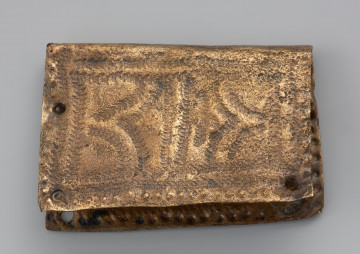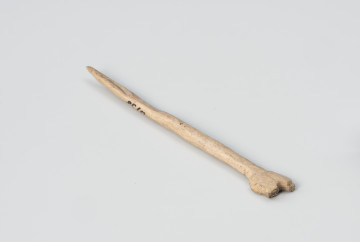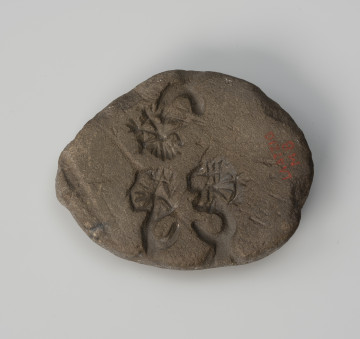
Leather sheath fitting
1001 — 1100
National Museum in Szczecin
Part of the collection: Middle Ages
The basalt whetstone found in the area of present-day Police is shaped like a bar expanded downwards. The hole at the top of it was drilled very precisely on both sides and was used to hang the object on a leather strap at the neck or at the waist. Indeed, whetstones were one of the basic items of personal equipment for the Slavs, acting as an accessory for clothing. The state of preservation of the presented piece indicates short-lived use, although the surface shows traces of sharpening of small tools, such as needles or fishing hooks. Pieces of this type were mostly produced from local raw materials, such as slate or sandstone. Basalt pieces were less common, which allows to presume that their owners were people of higher social or material standing. As one of the hardest magmatic rocks, basalt is difficult to work with, but resistant to abrasion and therefore very durable. Its minimal susceptibility to weathering, on the other hand, means that it was considered more valuable than other rock materials. An additional feature that emphasised the status of the person owning basalt products is the elegant appearance of this stone. Indeed, in the case of the whetstones worn on the outer parts of the garment, their aesthetic and prestigious qualities may have been as important as their utilitarian function. Ewa Górkiewicz-Bucka
Author / creator
Object type
whetstone, pendicle, costum sccessories
Technique
hewn, drilling, smoothing
Material
basalt
Origin / acquisition method
field research
Creation time / dating
Creation / finding place
Owner
Muzeum Narodowe w Szczecinie
Identification number
Location / status

1001 — 1100
National Museum in Szczecin

800 — 1200
National Museum in Szczecin

701 — 1150
National Museum in Szczecin
DISCOVER this TOPIC
National Museum in Lublin
DISCOVER this PATH
Educational path